In an earlier report, the Institute assessed that Russia had launched thousands of Shahed 136 drones against Ukraine through May 2024. [2] Although most of these relatively noisy, slow-moving drones have been shot down, about 14 percent of them on average penetrated Ukrainian air defenses, causing immense damage to its military and civilian infrastructure, particularly its energy infrastructure. This report updates those numbers and adds more information about drone interception rates.
The Russian manufacturer of these drones, JSC Alabuga, contracted with Iran in early 2023 in a $1.75 billion dollar franchise deal to supply 6000 of the drones to the Russian Army by September 2025. While there were initial delays and skepticism about Alabuga being able to supply 6000 drones, data on Russian launches of Shahed drones collected by the Ukrainian military indicate that Alabuga is ahead in its production schedule and has already supplied approximately 4500 of the promised 6000 drones as of late April 2024 and over 6000 by the end of August 2024.
Using data from January through August 2024, Alabuga has achieved an annual production rate estimated at about 4700 drones per year. Thus, Alabuga could fulfill its commitment of supplying 6000 drones one year early, by about the end of August 2024. If it continues acquiring all the required subcomponents from abroad, which are the vast bulk of the electronic components needed in the navigation and anti-jamming modules, it could supply an additional 4700 drones by September 2025 using the same data. Because shooting down all the Shahed drones has not been possible and jamming them has also proven difficult, stopping the supply of foreign components, particularly microelectronics, must be a higher priority. In that endeavor, Western semiconductor companies need to do much more to prevent their products ending up in Russian weapon systems. [3]
Number of Shahed 136 Launched by Russia
The Ukrainian Air Force, among others, publicly releases daily figures and periodically cumulative tallies of the number of Shahed 136/131 drones Russia has launched against Ukrainian targets. The values vary slightly among those tabulating the daily counts, reflecting inevitable uncertainties in counting and observing drones. It is also possible that not all Shahed's launched by Russia are reported publicly by Ukraine, given the possibility of failures upon launch or during early flight, and the difficulty of detecting all the drones in barrage attacks. Moreover, recent media states that Ukraine reports only the Shahed drones that it detects, [4] meaning that the number launched is likely larger. A new complication that could lower the monthly totals is that this summer Russia started to launch dummy drones fashioned to look like Shahed 136 drones as a way to overwhelm Ukrainian air defenses (see Sidebar). Through July 2024, however, these drones do not appear to have been used in large numbers. However, the situation for August is unknown, and the dummy drones can be produced quickly and in great numbers. Despite this uncertainty, the issue of dummy drones should not as of yet significantly affect the following analysis, where the intent is to correlate the number of Shahed launches with Shahed production at Alabuga.
For this report, taking into account the above uncertainties, we are relying on the Ukrainian Air Force estimates for the daily launch and interception counts which are then aggregated into monthly totals of Shahed launches. [5]
From the start of the full-scale invasion in 2022 to the end of 2023, Russian forces attacked Ukraine with nearly 4,000 Shahed drones; [6] adding monthly tallies for January through August 2024 from the daily values published by the Ukrainian Air Force, results in a cumulative total of 7550 drones as of the end of August 2024. See Table 1.
The increased production rate can also be viewed through the average number of Shahed's launched per attack. From April 2023 to September 2023, each attack contained an average of 14 Shahed drones, but then from September 2023 to August 2024, the average increased to 21 drones per attack. This larger average can be better understood by looking at the graph in Figure 1, a frequency distribution of strikes with a given number of Shahed drones. The average is 21 drones per strike and the median is 18 drones per strike.
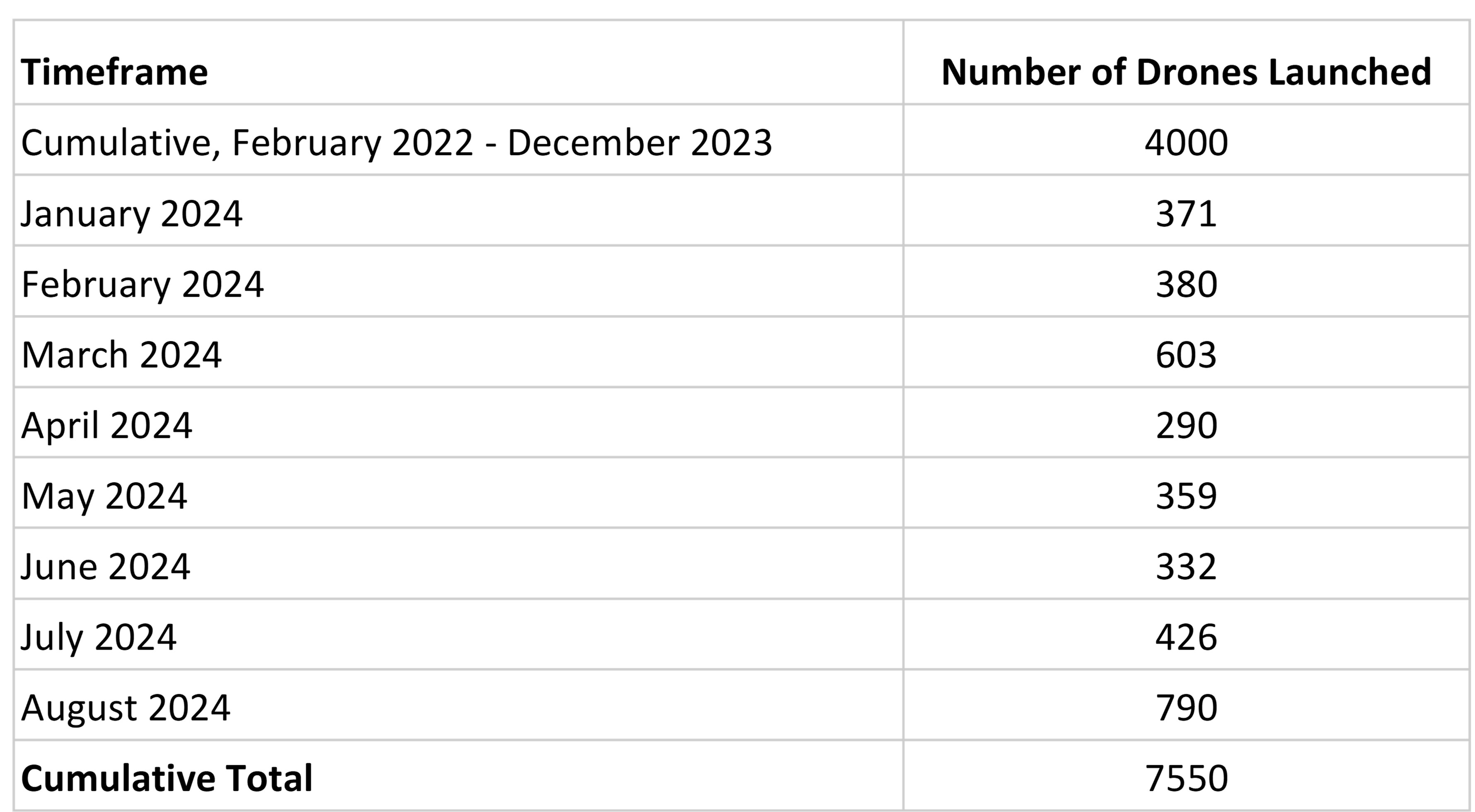
Table 1. Shahed 136 launches against Ukraine. Values from Ukraine Air Force tallies.
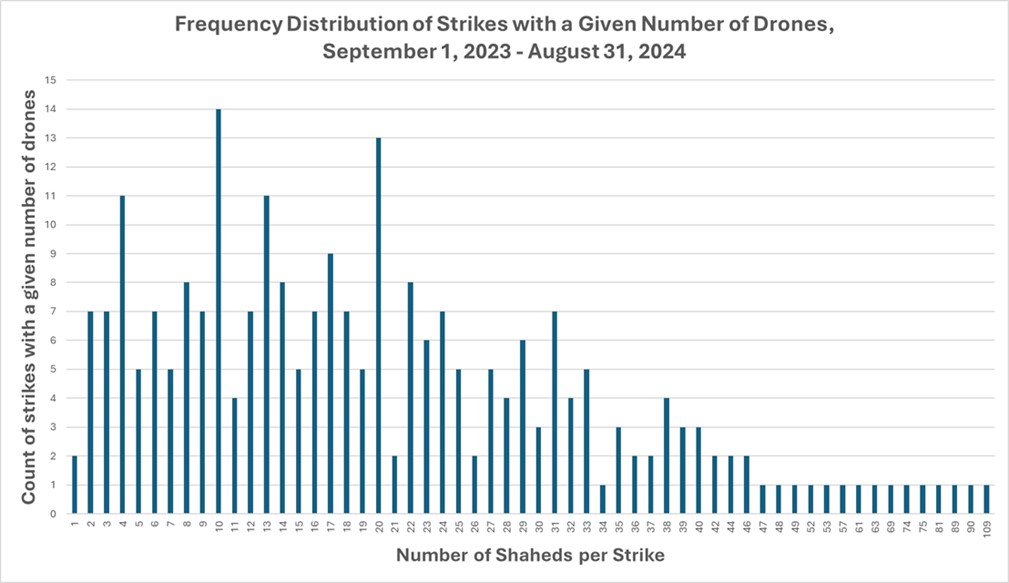
Figure 1. The graph shows the frequency of Shahed strikes with a given number of drone, from September 1, 2023, to August 31, 2024. Note: the horizontal scale on the far right side is compressed, reflecting far fewer strikes with more than 39 or 40 Shahed drones per strike.
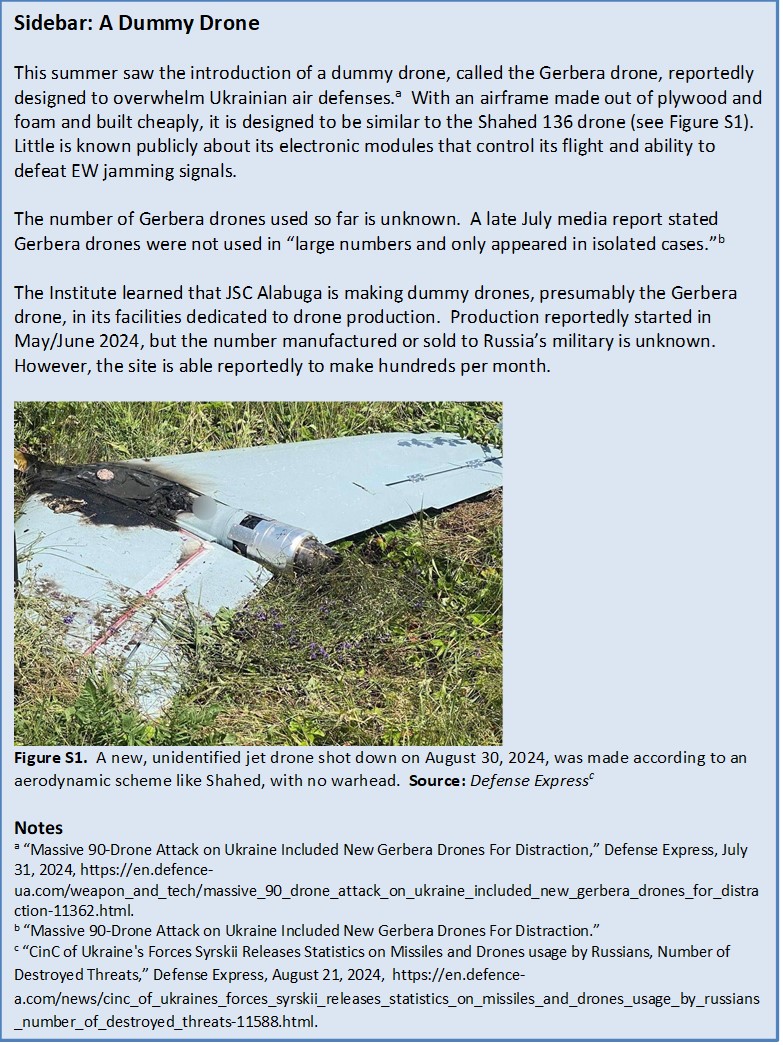
Shahed Drones Built by JSC Alabuga
With a recognition of the uncertainties discussed above, the numbers in Table 1 allow for an estimate of the production rates at JSC Alabuga, where it is also assumed that all the drones built by Alabuga are launched. Starting with the cumulative value of approximately 4000 Shahed drones launched through the end of 2023, it is necessary to subtract out those not manufactured by Alabuga or delivered by Iran directly to the Russian Army. This includes about 1100 Shahed drones launched before Alabuga provided drones to the Russian Army. In addition, Iran provided Alabuga with 600 disassembled drones in the initial stage of the contract. This means that in the nine months from April through December 2023, Alabuga manufactured at least the airframes for 2300 Shahed 136 drones, or an average of 256 per month. This is a larger number than expected for 2023 from the initial contract, where the value was slated to total 1332 drones for a monthly average of 148 drones per month. For 2024, Alabuga planned in its contract with Iran for an average monthly production rate of 226 per month. However, daily average production has increased in 2024, to an average of about 444 drones per month through August 2024, significantly larger than originally planned.
Figure 2 compares the number of drones Alabuga planned to supply under its contract with Iran to the number of drones launched by Russia, showing that the values line up from May 2023 - August 2023. In September 2023, the numbers start to deviate, with Alabuga supplying increasingly more drones to the Russian military than initially planned, reaching about 6400 by the end of August 2024. This means that Alabuga is finishing its initial contract with Iran more than a year early. The contract contains a Russian balloon payment of $500 million to Iran once Alabuga produces 6000 Shahed 136 drones, originally scheduled by September 2025. It is unclear if Russia's accelerated production requires JSC Alabuga to make the balloon payment earlier.
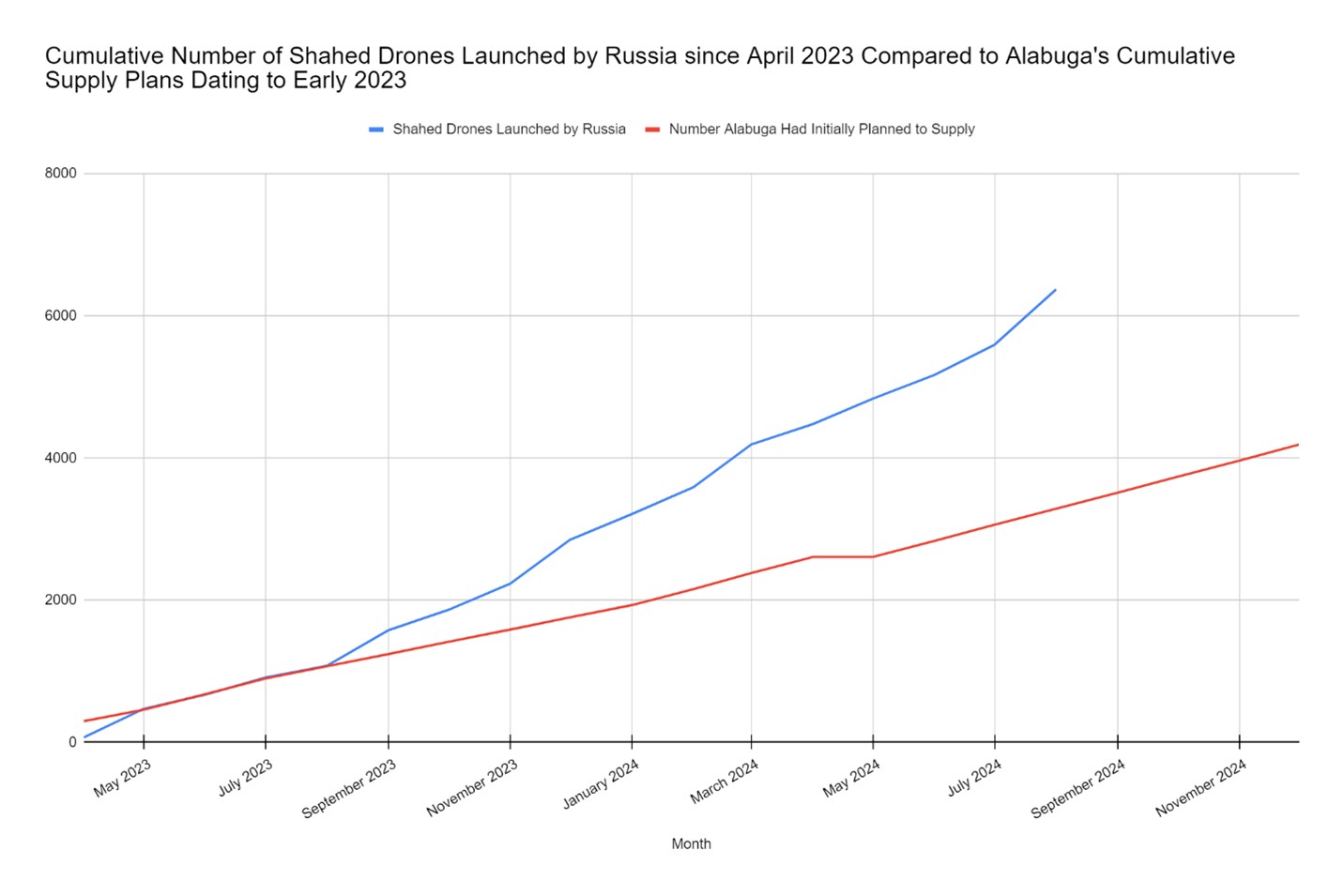
Figure 2. Number of Shahed drones launched by Russia since April 2023 compared to Alabuga's initial supply plans shows Alabuga ramped up production.
Figure 3 charts monthly Shahed 136 launches starting when Alabuga first began supplying drones to the Russian Army. It shows a trend of increasing launches overall, but also a pattern - which lasted for about a year, when a month of escalated drone strikes was followed by two to three months of fewer drone strikes. This could have resulted from the Russian Army stockpiling drones for periodic use in mass-scale attacks or fluctuations in the supply of drones from Alabuga.
The number of drone attacks decreased between April and July 2024, when Alabuga produced fewer drones on average each month, dropping from about 410 per month from January 2024 through April 2024 to about 371 Shahed 136 drones per month from May 2024 through July 2024. This drop may have reflected stockpiling of drones for later use, the possibility of less demand from the Russian military due to shifting priorities and economic constraints, production setbacks or cutbacks at the Alabuga plant, or less than desired stockpiles of imported materials resulting from difficulty in obtaining critical components from abroad.
However, August 2024 figures (and preliminary ones for September) show a sharp increase in the number of launches. Between August 1 and August 31, 2024, Russia launched 790 Shahed's against Ukraine, almost double the 426 launched during the same period in July 2024. Between September 1 and September 26, 2024, according to Ukrainian data, Russia launched 1131 Shahed's against Ukraine, almost triple the 426 launched during a similar period in July 2024. For the type of analysis done in this report, it is more urgent to more precisely determine the monthly number of dummy drones.
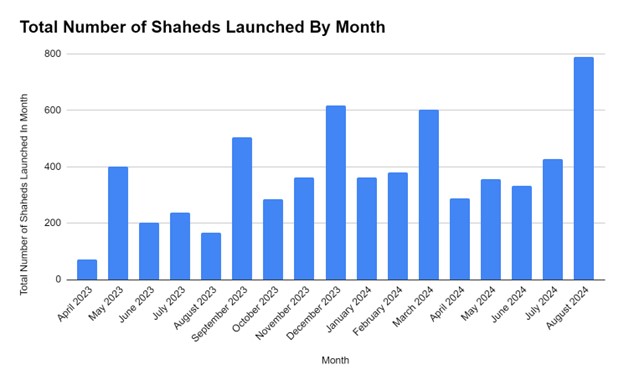
Figure 3. Number of Shahed 136/131 drones launched by Russia by month, covering April 2023, when Alabuga first began supplying drones to the Russian Army, through August 2024, according to data published by the Ukrainian Air Force.
Ukrainian Interception Rate of Shahed Drones
Ukraine is effectively intercepting large numbers of the Shahed drones launched at them, based on public data published by the Ukrainian Air Force. The drones are slow moving and audibly loud, making them easy to track and intercept with anti-air defenses, such as anti-air artillery batteries, interceptor missiles, and attack aircraft. Between April 2023 and the end of August 2024, Ukraine maintained an average interception rate of roughly 86 percent. Figure 3 below shows the interception rate month over month. February 2024 saw the worst interception rate at 77 percent while May 2024 had the highest rate of 97 percent. A dip in the interception rate can be seen from August 2023 until February 2024, whereafter the interception rate increases back to its earlier levels.
The increase in interception rate from March 2024 to August 2024, may reflect the additional supply of air defense systems, interceptors, and ammunition from Western backers and Ukraine's increasing adeptness at detecting and shooting down Shahed drones. Despite Ukraine's impressive performance in intercepting Russian Shahed drones, across the entire assessed time period, about 14 percent have managed to penetrate defenses. The 14 percent rate represents at least 878 Shahed drones over the assessed period. Russia may view its barrage strategy, despite the high interception rate, as effective, knowing that the small portion getting through will cause immense damage.
The commander-in-chief of Ukraine's armed forces recently released data on the number of Russian long-range weapons striking Ukraine, containing both the number launched and intercepted. [7] Unfortunately, the data aggregated the Shahed-136 drones with the Lancet drones, giving a combined total of 13,315 launches and 8836 interceptions, or an interception rate of 63 percent. However, the Lancet drone, also launched by the thousands since the start of the war, is a short-range drone that is more difficult to intercept than the Shahed 136 drone. In order to establish more reliable numbers, it would be useful if the Ukrainian armed forces released separate figures for each drone type.
It is instructive to estimate the number of Lancet drones launched against Ukraine, assuming that the values estimated above about the Shahed drones are reliable and the recent aggregate numbers are current. In this case, Russia launched about 6550 Lancet drones of which about 45 percent were intercepted.
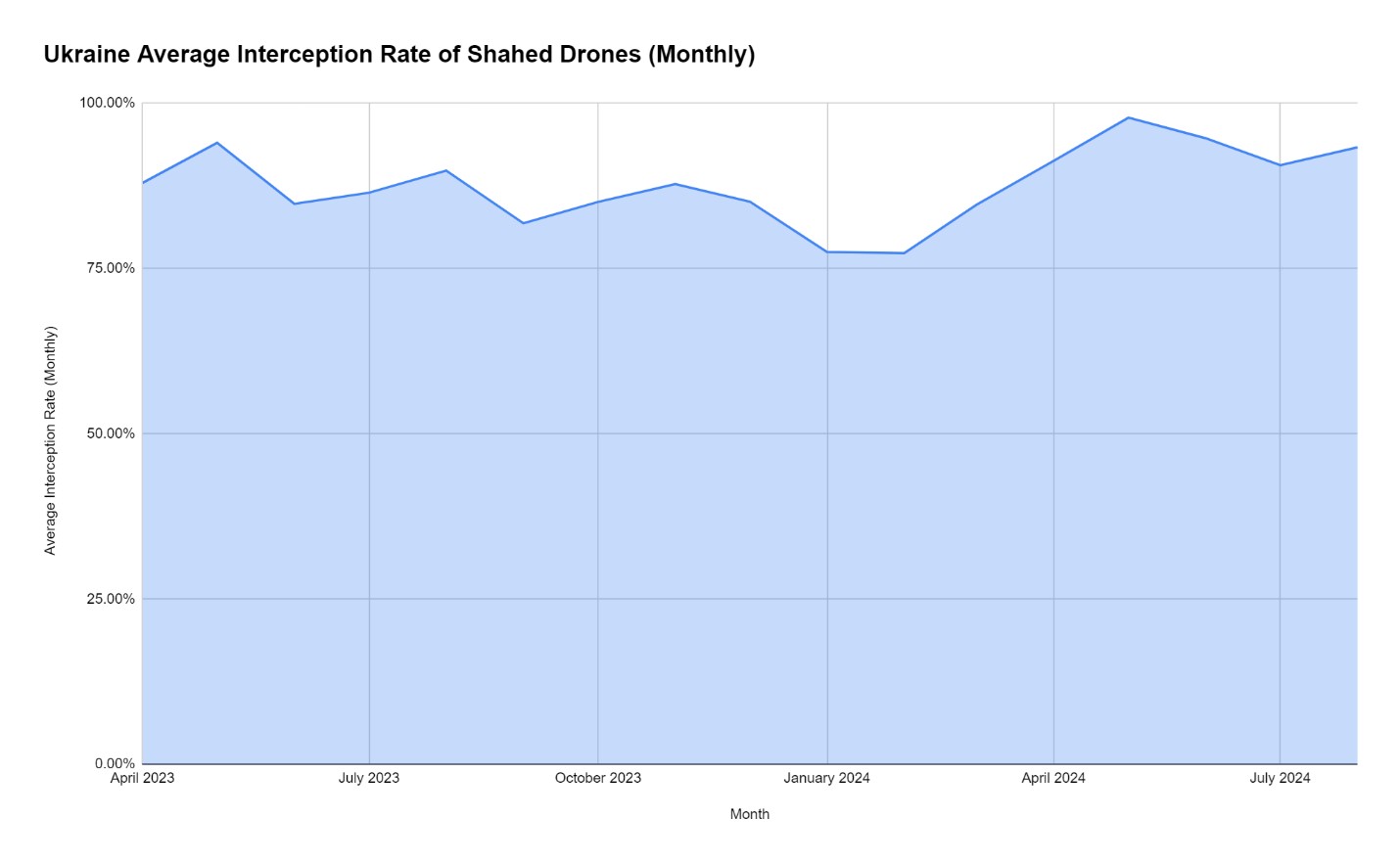
Figure 4. A chart showing month over month the average interception rate of Shahed drones launched at Ukraine based on numbers released by the Ukrainian Air Force.
Conclusion
A downside of Russia's barrage strategy, but a success for Ukraine and the West, is that Russia needs to launch 100 Shahed 136 drones in order to succeed on average of 14 hitting their targets. Even if the recent interception numbers by the Ukrainian commander in chief are accepted, and they should not be, given the difficulty of intercepting Lancet missiles, the rate would be 100 produced with only an average of 37 hitting their targets. These high loss rates mean that Alabuga must maintain a high production level and acquire a far larger number of electronics and other components from abroad.
Successful foreign procurements from China and the outsourcing of additional component production to other Russian enterprises, such as the production of warheads and anti-jamming units, likely played a critical role in enabling Alabuga to ramp up its drone production. Intensified efforts to block the exports of the many items needed in the Shahed, combined with increased attention to drone downing could bring the absolute number of successful drone attacks down.
1. Igor Anokhin's affiliation is the Institute for Nuclear Research, National Academy of Science of Ukraine. [↩]
2. David Albright, Dr. Igor Anokhin, Sarah Burkhard, Victoria Cheng, and Spencer Faragasso, "Alabuga's Greatly Expanded Production Rate of Shahed 136 Drones," Institute for Science and International Security, May 10, 2024, https://isis-online.org/isis-reports/detail/alabugas-greatly-expanded-production-rate-of-shahed-136-drones/8. [↩]
3. David Albright and Spencer Faragasso, "Action from Semiconductor Companies is Long Overdue," Institute for Science and International Security, September 23, 2024, https://isis-online.org/isis-reports/detail/action-from-semiconductor-companies-is-long-overdue. [↩]
5. Ukrainian reports have recently mentioned not only the number of drones shot down, but also those suppressed by electronic warfare, those that crashed, and those that crossed the border into Belarus. For example, the report of an attack that occurred on December 31, 2024, states, "24 strike UAVs shot down, 25 dropped on their own, three more flown to Russia and Belarus, Air Force Command of the UA Armed Forces, August 31, 2024, https://www.facebook.com/share/p/d4PMHo2qm8FLnuxA/. [↩]
6. Myroslava Tanska-Vikulova, "The Counteroffensive: Behind the scenes with a Ukrainian drone-hunting unit," Kyiv Independent, April 29, 2024, https://kyivindependent.com/the-counteroffensive-behind-the-scenes-with-a-ukrainian-drone-hunting-unit/. The number of 4000 launches is in line with an Institute estimate based on using monthly values, see "Alabuga's Greatly Expanded Production Rate of Shahed 136 Drones."[↩]
7. "CinC of Ukraine's Forces Syrskii Releases Statistics on Missiles and Drones usage by Russians, Number of Destroyed Threats," Defense Express, August 21, 2024, https://en.defence-a.com/news/cinc_of_ukraines_forces_syrskii_releases_statistics_on_missiles_and_drones_usage_by_russians_number_of_destroyed_threats-11588.html. [↩]






